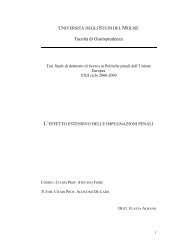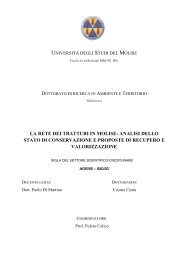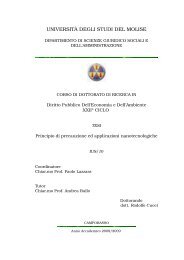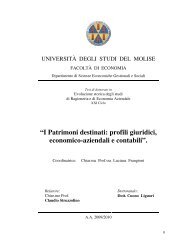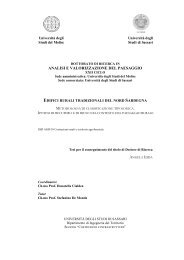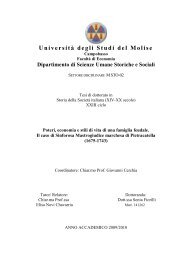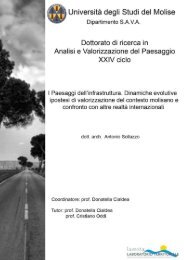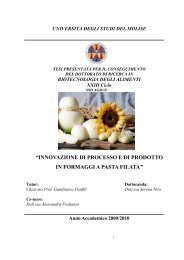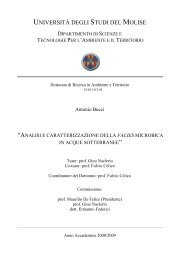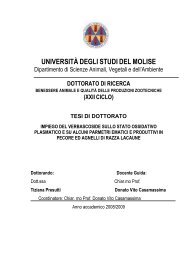TESI Dottorato FAVILLA MARA - Università degli Studi del Molise
TESI Dottorato FAVILLA MARA - Università degli Studi del Molise
TESI Dottorato FAVILLA MARA - Università degli Studi del Molise
Create successful ePaper yourself
Turn your PDF publications into a flip-book with our unique Google optimized e-Paper software.
Abstract<br />
The aim of this research work was to obtain the improvement of microbiological<br />
quality of traditional Apulian breads through the selection of lactic acid bacteria with<br />
antimicrobial activity and the characterization of bacterial contaminants (Bacillus<br />
spp.) from wheat semolina. Lactic acid bacteria are microorganisms used since<br />
ancient times for preparation of fermented foods such as some types of bread made<br />
with sourdough. The products of metabolism of lactic acid bacteria can extend the<br />
shelf life of bread due to their antimicrobial properties. The study of lactic acid<br />
bacteria in the wheat semolina used in the production of traditional Apulian breads<br />
may lead to the selection of strains with peculiar pro-technological characteristics for<br />
improvement of bakery product shelf life. Moreover, the use of antimicrobial<br />
metabolites as an alternative to sourdough that need a long fermentation time, may<br />
represent a new tool for control microbial contamination of bakery products.<br />
In this study, 30 samples of durum wheat semolina were subjected to<br />
microbiological analysis in order to explore their lactic acid bacteria diversity and to<br />
find strains with antifungal activity. The analysis led to the isolation of 250 isolates<br />
that were differentiated into 17 strains by rep-PCR. A representative strain of each<br />
rep-PCR pattern was used to identify the species. The sequencing of 16S rRNA<br />
gene allowed to identify the following species: Weissella cibaria, W. confusa,<br />
Leuconostoc citreum, L. mesenteroides, Lactobacillus plantarum, L. rossiae and<br />
Lactococcus lactis subsp lactis. In particular, W. cibaria and W. confusa showed the<br />
greatest genotypic variability and were the most wi<strong>del</strong>y diffused, since occurring in<br />
the 75% of the semolina samples. The antimicrobial activity of the fermentation<br />
products (FP) obtained by growing the 17 strains representative of the rep-PCR<br />
profiles in a flour-based medium, was evaluated in in vitro experiments against 3<br />
fungal contaminants of bakery products (Aspergillus niger, Penicillium roqueforti and<br />
Endomyces fibuliger) as well as against Bacillus subtilis, the causal agent of “bread<br />
rope”. The analysis led to the selection of 6 LAB strains belonging to the species<br />
Weissella cibaria, Leuconostoc citreum, Lactobacillus rossiae, L. plantarum e<br />
Lactococcus lactis showing antimicrobial properties. Among these strains, the<br />
fermentation product of L. citreum C2-27 showed a strong inhibitory activity towards<br />
the three above fungi, which was comparable to that of calcium propionate (0.3%,<br />
wt/vol), and also inhibited B. subtilis spore germination and <strong>del</strong>ayed the<br />
development of A. niger ITEM5132 directly on bread. Bichemical investigations<br />
carried out on the FPs suggested that antimicrobial activity was mainly related to<br />
lactic acid (26.28 mM) and acetic acid (14.62 mM) production, and to the low pH (pH<br />
= 3.42).<br />
Along with the use of natural preservatives, prevention and reduction of bread<br />
spoilage may be achieved also through the control of microbiological quality of raw<br />
materials. Recently, several companies in Southern Italy have reported problems of<br />
deterioration of bakery products due to the presence of spores of Bacillus spp. in<br />
raw materials. As part of this research, 59 samples of wheat semolina from different<br />
localities in the areas of Bari and Foggia were examined in order to assess the<br />
possible contamination by Bacillus spp. The study showed that approximately the<br />
90% of samples were contaminated by 10 0 -10 3 spores/g. Sixty percent of isolates<br />
were identified as B. subtilis/B. amyloliquefaciens and B. licheniformis, the two<br />
species most commonly associated with ropy bread spoilage.<br />
6




